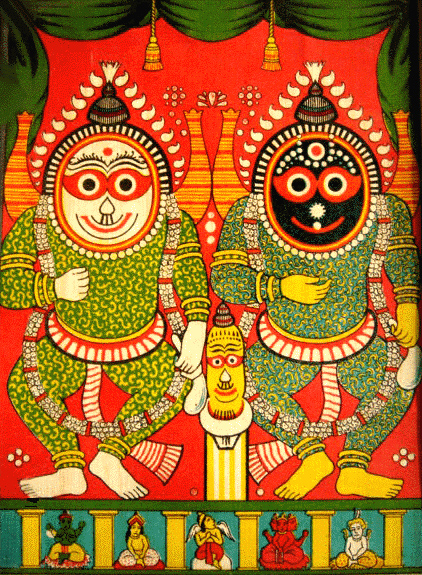The Names of Lord Jagannath
BY: SUN STAFF

Lord Jagannath, Baladev and Subhadra
Lithograph by Raja Ravi Varma
Mar 31, CANADA (SUN) — Lord Jagannath is loved and revered by devotees in the farthest reaches of the world, and He is known by so many different worshipable Names. During Ratha Yatra festivals we hear jubilant shouts of "Jai Jagannath! … Jai Baladev! … Jai Subhadra!", as the Lord is glorified in His position as brother amongst his two siblings. The name "Jagannath", or "Lord of the Universe", is invariably used to collectively refer to all three transcendental personalities. For example, when referring to "the Jagannath Deities", the devotees are also respectfully acknowledging Baladev and Subhadra.
Lord Jagannath was originally called "Purusottama" due to His original manifestation at Purusottam Kshetra (the abode of Purusottam), in Jagannath Puri. In the Rig Veda the Lord is referred to as the ‘Daru’ (sacred log of wood) of Purusottama, afloat on the eastern sea. As described below, these and many other names describe the pastimes, qualities and potencies of Lord Sri Krsna in His Jagannath Form.
One category of names for Lord Jagannath are those that refer to His beautiful round eyes. He is called "Chakaakhi", because chakaakhi means 'round eyes'. "Chakanayana" and "Chakaakshia" are similar forms of this Name. The Lord is also known as "Chakadola", which refers to His round lid-less eyes, which symbolize that the Lord is constantly and vigilantly watching over His devotees. These Names also distinguish the fact that Lord Jagannath's eyes are unlike those of Lord Balabhadra and Goddess Subhadra, whose eyes are typically depicted as oval or slanted while the Lord's are completely round in shape.
The various meanings of "Chakadola" have been interpreted by scholars, as follows: [1]
"One of the avataras (incarnations) of Lord Vishnu is Matschhya (fish) avatara. Rohita (Rohi fish) and Animisha (having no eye-lids) are two names of Vishnu out of His one thousand names ( Vishnu sahasra nama), which indicate Matschhya avatara. The round lid-less eyes, like that of fish, symbolise that Lord Vishnu or Jagannath is ever active and vigilant. To Him, days, nights and fatigue make no meaning. Sun and Moon are the two eyes of Lord Vishnu. Hence, His eyes are round in shape (" Sashi Surya netram ", Gita).
The eye-index of Lord Jagannath is higher than that of the images of deities belonging to many ancient civilizations e.g. the Indus valley, the Mexican and Egyptian civilizations. Hence, it could be presumed that Lord Jagannath is a very ancient deity in the world."
Over the years, many followers of Lord Buddha have also embraced Lord Jagannath, endowing Him with certain aspects and characteristics that are inherent to Buddhism. For example, in some Orissan pata-chitra folk paintings depicting scenes of the Dasavatara, the ten primary incarnations of Visnu, the place of Lord Buddha is filled with an image of Lord Jagannath, instead. Not surprisingly, these adherents have also concluded that Lord Jagannath's large round eyes have meaning in Buddhist symbolism. They state that the Lord's round, wheel-like eyes illustrate the concept of nirvana. The soul, passing through many births, completes the circle and attains liberation after having traveled repeatedly around the great wheel. Sri Jagannath's eyes are that wheel, or are like a symbolic mandala of the wheel.
Because Lord Jagannath is Sri Krsna Himself, many of the Supreme Personality's Names are also used to describe Lord Jagannath. Jagannath, 'Lord of the Universe', is popularly known as "Padmalochana" (Lotus-eyed). He is also called "Jagadish" or "Jagatadhisha" (the 'King of the Universe), "Jagabandhu" (the 'Friend of the World), "Patitapavana" (Who Blesses the Most Fallen), Jagamohana, and Deena-bandhaba.
The Lord has many other Names that refer to his transcendental rulership over the worlds, including "Purusottama" (the 'Supreme Man), "Devadhideva" (Lord of Lords), and "Rajadhiraj" (King of Kings).
In describing Lord Jagannath's wooden Deity Form, He is called "Daru-brahma" Daru-brahma means the wooden (daru) image containing the Supreme Soul (the Brahma). In the sacred body of Lord Jagannath, the ‘Brahma’ (Supreme Soul) has been kept in a cavity. This manifest representation is transferred from body to body as the wooden Form is periodically replaced. (See the "Navakalevara of Lord Jagannatha")
As Daru-brahman, the Lord is shrouded in mystery. While we behold His beautiful Form, the Lord's Brahman is invisible, too subtle for our conditioned material eyes! The Kena Upanishad (1.5.9) states, "That which is not seen by the eye, but by which the eye sees - know that to be Brahman".
There are numerous other Holy Names of Lord Jagannath that describe His other manifest qualities and pastimes. He is called "Kala Thakura", which refers to the fact that He is a black coloured God. Similarly He is known as "Kala Simha" (Black Lion) and "Kalia Kanbu" (Dark Darling).
Just as we find reference to Mahaabaahu in Bhagavad-gita 1-18, referring to "big-armed", Lord Jagannath is known as "Mahaabaahu", being big-handed, which symbolizes that he reaches out to help all the jivatmas. This Name is particularly sweet given that the Lord's Daru-brahma body is without arms.
Lord Jagannatha is called by the name "Nilachalia", because He lives in Nilachala, on the great dark hill. Locally he is worshipped today as "Neeladrivihari", having been worshipped in the past as "Neelamadhab" by an aboriginal chief.
Of all the Names used to describe our beloved Lord Jagannath, however, perhaps the most heartfelt of all is His Name, "Bhavagrahi" - He Who Cares for the Feelings of the Devotee. This is the practical manifest presence of the Lord that is felt by all who gaze into His loving eyes.
FOOTNOTE:
[1] Mahimohan Tripathy, Bhubanesvar
